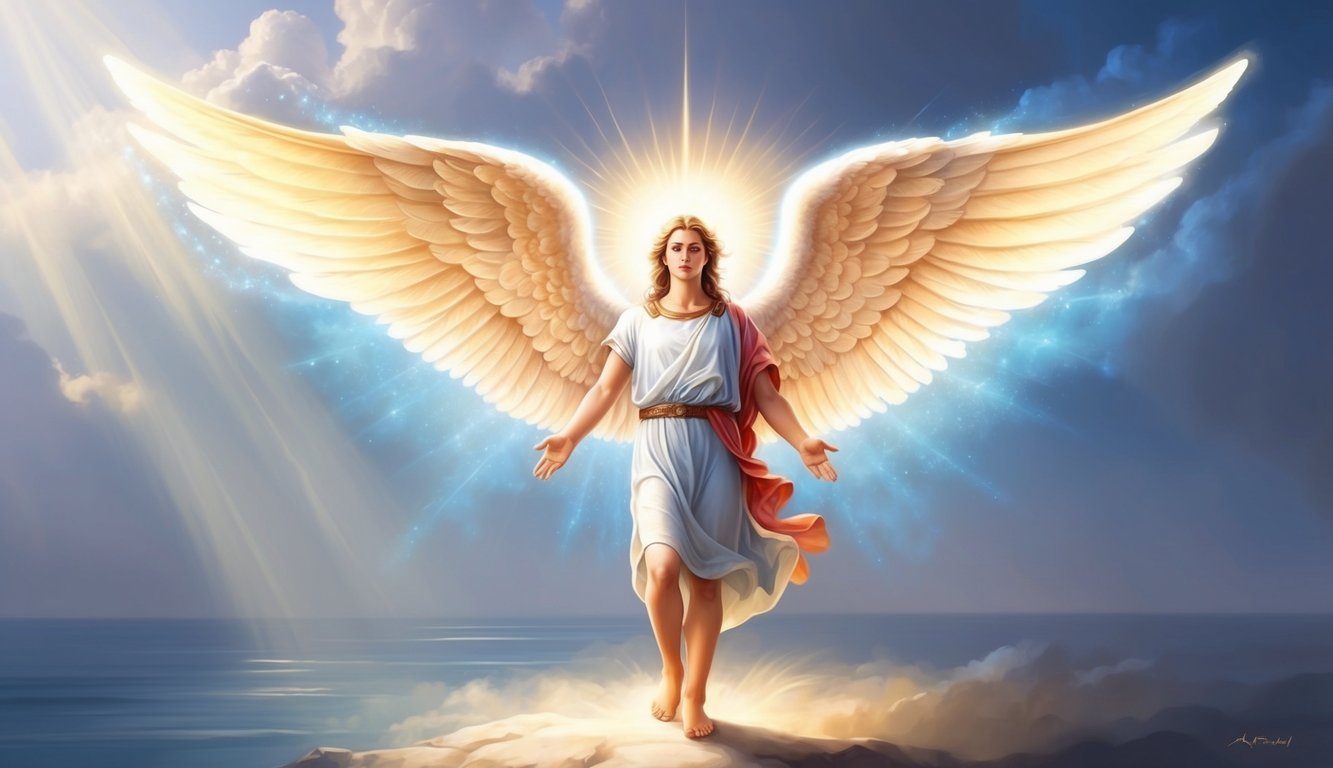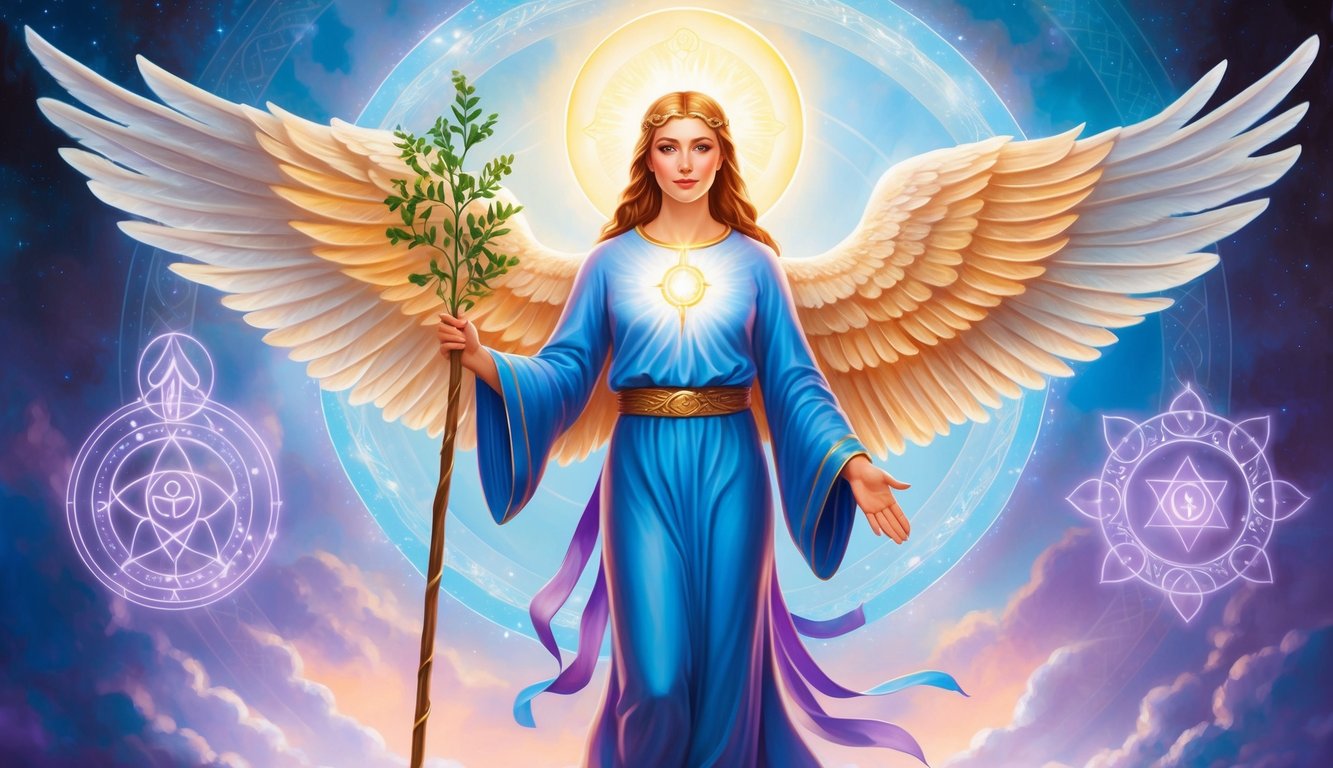Don’t Miss Out On This Unique Astrological Opportunity
Are you tired of spinning your wheels and getting nowhere? Simply put, you’re out of sync: you’re out of alignment with your astral configuration.
But: there’s a kind of map that can help you reclaim your alignment. Think of it as your own personal blueprint to success and happiness: a blueprint that will help you live your most amazing life.
Get started here.
When you explore the tales of the Archangel Raphael, you uncover stories of healing, protection, and guidance woven through religious texts. Raphael is often revered as a divine protector, offering solace and assistance in times of need.
He is known for his role in guiding Tobias in the Book of Tobit, where he brings physical and spiritual healing.
Imagine having an unseen ally guiding and safeguarding you through life’s challenges.
Many believe that Raphael’s presence offers comfort and strength.
This notion resonates with those seeking spiritual support, drawing on the angel’s reputed abilities to heal both body and spirit.
Whether you’re familiar with these stories or new to them, learning about Raphael opens a window into rich cultural and spiritual traditions.
His story intertwines not only with the divine but also with everyday moments where you might need extra support.
Discover more about this angelic protector and the ways he can inspire and enhance your spiritual journey.
The Role of Archangel Raphael in Spiritual Healing

Archangel Raphael is known as a divine healer.
In various religious traditions, people turn to Raphael for spiritual healing and guidance.
Understanding his healing powers can enrich your spiritual practices.
Understanding the Healing Powers of Archangel Raphael
Archangel Raphael is often called the divine healer.
He is dedicated to healing both physical ailments and emotional suffering.
His energy is believed to offer comfort and peace.
Raphael is connected with green light, which symbolizes healing and renewal.
When you seek Raphael’s aid, you’re inviting healing energy into your life.
This connection can lead to positive changes in how you feel mentally and physically.
Some people feel a sense of calm, others find physical relief, and many experience emotional support.
Christians believe that Raphael can guide you through tough times and toward greater faith.
The archangel’s protective presence is reassuring.
By opening your heart and mind, you allow his healing powers to work within you, transforming challenges into growth.
Prayers and Practices for Invoking Divine Healing
Praying to Archangel Raphael involves sincere requests for healing.
Many people start with a simple prayer, asking Raphael to fill them with healing light.
Feel free to use words that express your personal needs and feelings.
You can also incorporate spiritual practices to enhance your connection with Raphael.
Meditation can be a powerful way to invite his healing presence.
Focus on breathing deeply and visualizing green light surrounding you.
Some choose to use objects like crystals or candles in their practice to symbolize Raphael’s energy.
These can serve as reminders of the divine support available to you.
Whether through quiet reflection or spoken prayer, inviting Raphael’s healing into your life can inspire hope and faith.
Archangel Raphael Across Different Religions
Archangel Raphael is a significant figure across Judaism, Christianity, and Islam.
Each religion views Raphael uniquely, yet they all recognize his protective and healing qualities.
Raphael’s Presence in Judaism
In Judaism, Raphael is often associated with healing.
He appears in the Book of Tobit, part of the Hebrew Bible’s Deuterocanonical books.
In this story, Raphael disguises himself as a human to assist Tobias on his journey, providing protection and healing guidance.
Raphael’s name, meaning “God heals,” reflects his role as a divine healer.
While he doesn’t appear directly in the Torah, references to him can be found in other Jewish texts, like the Book of Enoch, which further highlights his healing powers and protective nature.
Jews often regard Raphael as a guardian angel who watches over humanity.
Raphael’s Significance in Christianity
In Christianity, Raphael is regarded as one of the seven archangels and a protector of travelers.
His primary appearance is in the Book of Tobit, where he helps Tobias and cures Tobit’s blindness.
Many Christians view Raphael as a mediator between God and humans, guiding and healing those in need.
Churches sometimes celebrate his feast, recognizing his role in the divine plan.
Raphael’s significance extends to his symbolization of healing and protection, commonly invoked in prayers for those who are sick or on a journey.
This connection underscores Raphael’s continued importance as a divine figure offering comfort and aid.
References to Raphael in Islam
In Islam, Raphael is known as Israfil.
Although not directly mentioned in the Quran, he is considered one of the four major archangels, tasked with blowing the trumpet to signal the Day of Judgment in Islamic eschatology.
Muslims regard him as a key figure in the events of the end times.
Unlike Judaism and Christianity, Islam emphasizes Raphael’s role related to the ultimate fate of the universe rather than individual healing.
Despite the differences, Raphael’s involvement in Islamic texts highlights his universal importance across various religious traditions.
Raphael: The Patron Saint of Travelers and Healers
Archangel Raphael is recognized for his critical role in offering protection and guidance to travelers.
He is also a comforting presence for those in the medical field, including doctors and nurses.
Let’s explore his significance in both these areas.
Protector of Travelers and Guide for Safe Journeys
When you embark on a journey, you can find comfort in knowing that Raphael is there to safeguard you.
Known as the patron saint of travelers, Raphael is believed to offer guidance and ensure your safety on the road.
His presence brings a sense of security, making it easier for you to venture into the unknown with confidence.
Raphael’s role as a protector is highlighted in various religious texts, where he guides characters who travel long distances.
For those who seek assistance, a simple prayer to Raphael can bring peace and assurance.
His protective qualities are also celebrated annually, especially by those who frequently travel.
The Guardian Angel for Medical Workers
In the field of medicine, Raphael is honored as a guardian angel for doctors, nurses, and other medical workers.
He is cherished for bringing healing powers and wisdom to those who care for the sick.
Medical professionals may invoke Raphael to help them succeed in their vital roles.
Raphael is often depicted with a caduceus, a symbol associated with healing and medicine.
His connection with this role has made him a beloved figure for anyone seeking recovery or strength during illness.
If you work in healthcare, you might find solace in asking Raphael for guidance and protection.
The Iconography and Symbols Associated with Raphael

Raphael, known as a guardian and healer, is often depicted with symbols like the caduceus and the color green.
These elements highlight his role in providing comfort and protection.
Artistic Depictions and the Color Green
When exploring artistic images of Raphael, the color green stands out.
Artists often use emerald and malachite shades, representing growth and life. Green robes or backgrounds in art symbolize his healing nature and connection to creation.
Not only does green symbolize vitality, but it’s also linked to jewels like jade.
Raphael’s presence in these artworks can bring to mind the lushness of nature.
The color also emphasizes his calm and peaceful energy, making it a key feature in art depicting him.
Raphael’s Emblematic Caduceus and the Interconnection with Healing
The caduceus is a common symbol with Raphael, reflecting his role in healing.
This staff, entwined with two snakes, represents balance and health.
You often see Raphael holding the caduceus in religious artworks, which highlights his responsibilities in offering spiritual and physical healing.
Associated with medicine today, the caduceus connects to Raphael’s mission to protect and restore health.
This symbol serves as a reminder of his ongoing task to provide healing and guidance.
You can see the caduceus in various artistic and religious contexts, aligning him closely with caretakers and healers throughout history.
Celebrating Archangel Raphael: Feast Day and Honors

You can honor Archangel Raphael through dedicated feast days and daily practices that acknowledge his role as a divine protector and healer.
These traditions highlight his significance as a guide and helper in various aspects of life.
The Meaning of Feast Day Observations
The feast day dedicated to Archangel Raphael offers a special time for reflection and devotion.
It typically occurs on September 29, shared with other archangels like Michael and Gabriel.
During this time, you can engage in religious traditions that emphasize Raphael’s role as a healer and protector, such as attending church services or participating in community events that bring people together in prayer and celebration.
In many religious communities, the feast day includes specific holy observances.
These can involve special prayers, hymns, and even processions that highlight Raphael’s intercession.
You might also find opportunities to read scriptures that tell of Raphael’s actions and virtues.
Hosting a small meal or gathering can also be part of the commemoration, providing a space to honor his guidance.
Honoring Raphael in Daily Life
Incorporating Raphael into your daily life doesn’t have to be limited to feast days.
You can take simple steps to honor him as a divine protector and healer.
Begin by setting aside moments for quiet reflection or prayer.
Ask for his guidance and protection in daily struggles.
Lighting a candle in his honor or meditating quietly can be ways to create a sacred space in your home.
You may also choose to engage in acts of kindness and healing as a tribute to Raphael.
Helping those in need, whether through volunteering or offering support to friends and family, echoes his healing spirit.
Consider keeping a small symbol, like an image or medal, as a daily reminder of his presence and the protective, healing qualities he embodies.



